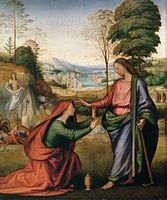ノリ・メ・タンゲレ

ノリ・メ・タンゲレ(ラテン語: Noli me tangere、私に触れるな)は、ラテン語聖書ヨハネによる福音書20章17節に登場する文句である。イエスが復活の後にマグダラのマリアに対して放った言葉だとされる[1]。原典ギリシア語では Μή μου ἅπτου (mē mou haptou) で、英語からの重訳では「私をつかむのは止めなさい("cease holding on to me")」あるいは「私にしがみつかないでください("stop clinging to me")」である[2]。古代から現代におけるキリスト教美術の図像学では、イエス・キリストは復活後マグダラのマリアの前に存在を現わすとされる。例えば、パブロ・ピカソは、青の時代の代表的な絵画『ラ・ヴィ』(クリーブランド美術館所蔵)の発想源として、コレッジョの『ノリ・メ・タンゲレ』(プラド美術館所蔵)を使用した[3]。
文学的用法[編集]
絵画の題材などに繰り返し使われてきたイエスのこの言葉は、劇的な台詞であるためもあってか、半ば慣用句に使用されている。有名なものには、フィリピンの革命家ホセ・リサールによる小説『ノリ・メ・タンヘレ』Noli Me Tángere がある。また、ホウセンカの英名touch-me-notは同語の英訳に由来しており、触れると種を弾き飛ばすホウセンカの性質を聖書の言葉で言い表している例である。
関係する絵画[編集]
-
フラ・アンジェリコ『ノリ・メ・タンゲレ』(サン・マルコ修道院所蔵)
-
マーティン・ショーンガウアー『ノリ・メ・タンゲレ』
-
フラ・バルトロメオ『ノリ・メ・タンゲレ』(1506年)
-
ティツィアーノ・ヴェチェッリオ『ノリ・メ・タンゲレ』(1515年頃)
-
アレクサンドル・アンドレイェヴィチ・イワノフ『ノリ・メ・タンゲレ』(1858年)
脚注[編集]
出典[編集]
- ^ See, for instance, "Touch Me Not" by Gary F. Zeolla or Greek Verbs. In fact the form of the verb used is not the aorist imperative, which would indicate momentary or point action, but the present, which indicates an action in progress (Lesson Five – Greek Verbs). When, later in the same chapter, Jesus invites Thomas to touch his side, the aorist imperative is used to indicate the proposed momentary action (John 20:27). See also Jeremy Duff, The Elements of New Testament Greek, 7.2.2. "The difference between the Present and Aorist Imperatives"
- ^ See G. Schiller, "Ikonographie der christlichen Kunst", vol. 3, Auferstehung und Erhöhung Christi, Gütersloh 2 1986 (ISBN 3-579-04137-1), pp. 95–98, pl. 275–297; Art. Noli me tangere, in: "Lexikon der christlichen Ikonographie", vol. 3 Allgemeine Ikonographie L–R, Rom Freiburg Basel Wien 1971 (ISBN 3-451-22568-9), col. 332–336.
- ^ Gereon Becht-Jördens, Peter M. Wehmeier: Picasso und die christliche Ikonographie. Mutterbeziehung und künstlerische Position. Reimer, Berlin 2003, esp. pp. 39–42, fig. 1–4 ISBN 3-496-01272-2





